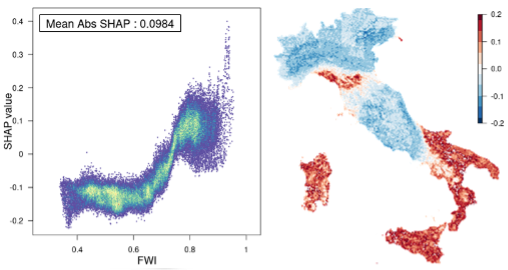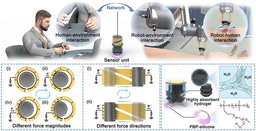Explainable Artificial Intelligence (XAI) detects wildfire occurrence in the Mediterranean countries of Southern Europe
Published in Earth & Environment

Climate change is exacerbating the occurrence of environmental disasters and their effects on everyday life causing ecological and social impacts which require the implementation and enforcement of effective disaster risk management and preventive measures. In particular, the number of large fires is increasing, as several studies have suggested, along with the evidence that their impact and severity have worsened. Southern Europe and more specifically Mediterranean countries like Italy represent an interesting case study, as this region is characterized by a considerable heterogeneity of landscapes and ecosystems due to a complex geological history, different climate regimes and anthropic influences. This year (2022), the Italian Fire brigade has reported the occurrence of 33,000 wildfires across the whole peninsula between June 15 and July 21. Obviously, the exceptional hot and dry climatic conditions of this past summer have played a relevant role in such a dramatic scenario. However, to neglect the impact of anthropic interventions, such as arsons due to criminal activity, would be naive. As a team of researchers of the University of Bari in the Apulia region, we feel particularly a part of this scenario, and not only for scientific purposes.

Methodological overview. Environmental, biophysical, and human-related variables are used to model wildfire occurrence over the Italian peninsula. In addition, the computation of the SHAP values provide a disentanglement of the single contribution to the overall fire occurrence probability predicted by our Random Forest classifier.
We therefore decided to develop a quantitative methodology for wildfire risk assessment, aware of the challenges posed by such an issue. Nevertheless, we believe that remote sensing observations provide a sufficiently reliable knowledge base to estimate such risk. Thus, our primary goal is to develop a tool that could potentially support the monitoring and protection of this region, but a rough estimate is not enough. Narratives are of paramount importance to support policy makers and stakeholders. Therefore, we designed a two-step procedure which (i) evaluates wildfire risk based on Artificial Intelligence (AI) and (ii) provides a direct and easy-to-interpret explanation of wildfire driving factors.
Although wildfires have been extensively studied, a single unified and reliable model is lacking which offers a comprehensive explanation of their occurrence. The main reason why is that wildfires depend on several factors and interactions. In many analogous situations, a possible choice is to entrust the model to machine learning algorithms without any a priori assumption. Accordingly, we designed and implemented a workflow based on a Random Forest (RF) classifier. RF is a state-of-the-art classifier that ensures performance accuracy with a relatively simple tuning process, as the main parameters determining its performance are the number of trees in the forest and the number of features randomly selected at each node split. Because the primary goal of the model is to provide a robust wildfire risk assessment, we preferred a relatively simple model (compared with other more sophisticated solutions, e.g., deep neural networks) minimizing fine tuning and overfitting issues. Our findings demonstrated the efficacy of this choice with an area under the curve (AUC) of 81.3%. On the one hand, the performance confirmed that wildfire occurrence can be robustly predicted; similar results have been achieved by independent studies using different designs, algorithms, and data. On the other hand, this classification task was shown to be extremely challenging; it should be kept in mind that “external” factors such as arsons make certain events totally unpredictable. Nonetheless, as the classification performances demonstrate, the available indicators provide a reliable knowledge base for wildfire risk modeling.
Once the reliability of the available indicators for wildfire risk modeling was demonstrated, our second target was the identification and evaluation of features which mostly affect wildfire risk. In recent years, an increasing number of AI studies have been devoted to making their findings interpretable and accessible even to non-AI experts; the eXplainable Artificial Intelligence (XAI) domain is the research field attempting to address this concern. In our work, we proposed the adoption of an XAI approach based on Shapley values to deepen our understanding of the phenomena underlying wildfires. We aimed at a two-level explanation: first, our goal was the development of a framework capable of outlining wildfire driving factors at a regional/national level. The purpose was to provide regional/national governments with a tool supporting the adoption of global policies. Second, we were aware that each forest has its peculiar characteristics; thus, it is reasonable to provide an explanation based on the local specificities.

Left panel: Partial dependence plot generated by comparing the Fire Weather Index (FWI) observations with their related SHAP values. Right panel: Spatial distribution of the Fire Weather Shapley values.
Our findings highlight the overall importance of the Fire Weather Index (FWI) to explain the vast majority of wildfires. This is not surprising, as the FWI basically accounts for the presence of climatic conditions that favor fire risk. Other interesting features worth investigating in relation to wildfire risk are the Normalized Difference Vegetation Index (NDVI) and the slope of the terrain?). Naturally, when the framework is not applied to particular situations other features can become relevant; for example, the presence of agriculture, shrubs, or the distance to urban conglomerations, just to mention a few.
In addition, our findings demonstrate that in a heterogeneous territory, such as the Italian peninsula, XAI is efficient and statistically robust for analyzing wildfire occurrence. Consistency was found with other studies in identifying climate as the main driver of wildfire occurrence. Not secondary to the motivation for our research was the desire to enrich the scientific literature on AI applied to such stochastic natural disasters as wildfires. This field of research still has much room for improvement. We intend to corroborate the ever-growing body of scientific evidence on AI and encourage new research and projects on the operational use of machine learning models, as they are yet viewed with skepticism by insiders and decision makers. In contexts where the human and natural spheres constantly intermingle and interact, the XAI framework could assist forest managers to prevent and mitigate future disasters and develop strategies for effective fire management, response, recovery, and resilience. These approaches can also be easily generalized and adopted for other environmental monitoring purposes.
Follow the Topic
-
Scientific Reports

An open access journal publishing original research from across all areas of the natural sciences, psychology, medicine and engineering.
Related Collections
With Collections, you can get published faster and increase your visibility.
Reproductive Health
Publishing Model: Hybrid
Deadline: Mar 30, 2026
Women’s Health
Publishing Model: Open Access
Deadline: Feb 14, 2026





Please sign in or register for FREE
If you are a registered user on Research Communities by Springer Nature, please sign in